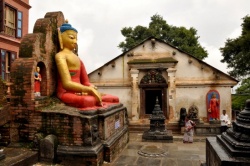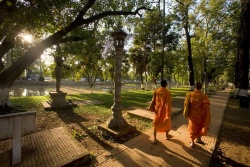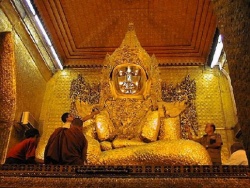The Mistranslation of Sangha into Chinese and Japanese
The Meaning of the Three Treasures by Shin Yatomi
On the morning of October 6, 1536, an Englishman was strangled and burned at the stake in Belgium after sixteen months of imprisonment. William Tyndale was charged with translating the Bible from the original Hebrew and Greek texts into English—against the will of the Roman Catholic authorities. After his death, his name was largely forgotten, but his translation survived the relentless book burings instigated by the bishop of London and eventually became the basis of the King James version to reach millions of English-speaking readers until today. Tyndale’s enemies, including Sir Thomas More, vehemently attacked his new and daring translations of some key biblical terms.
Tyndale translated, for example, the Greek words ekklesia as “congregation” instead of “chruch” and presbyter as “elder” instead of “priest,” and he was correct.[1] Scrolls and dictionaries—these were not the only things the translators of sacred texts had to deal with in the past; they also had to listen to (or choose to ignore) the voices of those dressed in holy robes. As we see in Tyndale’s tragic death, the translation of sacred texts has been often a source of contraversy involving religious authority, and Buddhism is no exception in this regard.
As many Buddhist texts in Pali and Sanskrit were translated into Chinese in the early centuries of the Commn Era, the original meanings of some words were obscured in the process—sometimes deliberately to suit the translating monks’ or their superiors’ personal motives and circumstances. One such mistranslated word is sangha (also spelled samgha), which meant the Buddhist Order in the context of Buddhist scriptures. During Shakyamuni’s time, the same term described a number of political groups and trade guilds; it was also applied to religious groups.[2] The general notion of the sangha included the four groups of Buddhists: monks (bhiksu), nuns (bhiksuni), laymen (upasaka) and laywomen (upasika).[3] When it is used in early Buddhist texts, however, the term usually refers to the two orders of priesthood: the order of monks (bhiksu-sangha) and the order of nuns (bhiksuni-sangha). The Buddhist Order was often called samagra-sangha or “harmonious order.” It was thought that members of the sangha should practice in harmony since they share the same goal of attaining enlightenment.[4]
Sangha was translated into Chinese as seng-chia. (To be precise, this was a transliteration of the term.) Seng, the Chinese abbreviation of seng-chia, however, came to be used to indicate an individual monk although, in India sangha never carried this meaning. In India, an individual monk was referred to as bhikkhu or bhiksu. In Buddhist texts, the usage of the term sangha was strictly distinguished from that of bhikkhu or bhiksu. The sangha was considered one of the three treasures of Buddhism along with the Buddha and the Dharma (i.e., his Law or teaching), but an individual monk was never considered an object of veneration as an element of the three treasures.
I-Ching (635–713), a Chinese Buddhist scholar, after visiting many Buddhist sites in India, pointed out to Chinese Buddhists this misapplication of the term sangha to individuals.[5] Many scholars acknowledged the error, but they insisted on continuing to use the term to refer to an individual priest or monk.
This misuse of the term was simply accepted by the Japanese when Buddhism took root in Japan, as well. The Japanese term so, the Japanese pronunciation of the Chinese seng of seng-chia, came to signify an individual priest. As a result, this mistranslation significantly altered the concept of the three treasures in China and Japan. Particularly in Japan, the term was misused to promote reverence toward an individual priest. It is this misinterpretation that Nichiren Shoshu has been leaning on to dogmatically define its high priest as being part of the three treasures.[6] As discussed earlier, the treasure of the sangha originally referred to the Buddhist Order, which, in the broadest sense, included all Buddhists, both priests and lay believers. The sangha was revered especially after Shakyamuni’s death precisely because the Buddhist community as a whole fulfilled the important role of preserving and spreading the Buddha’s teaching.
In light of those historical facts, the components of the three treasures would best be expressed as the Buddha, the Dharma and the sangha in order to maintain the original meaning and intent of the concept. The “Law” or the “Teaching” for the Dharma, and the “Order” or “Community” for the sangha may be permissible if English terms are preferred. In terms of etymology and common usage, the word order is more associated with ecclesiastical or monastic hierarchy; the word organization, which we often use to describe the SGI, was originally related to the vital functions of a living body but now sounds bit unorganic and cold; the word community, however, still retains a sense of the Lain word communitas or fellowship, which is akin to the spirit of samagra-sangha or “harmonious order.” But translating the treasure of the sangha as “the treasure of the priesthood” would be a diminution of the original term, and “the Treasure of the Priest”[7] an outright distortion. In the Writings of Nichiren Daishonin, the treasure of sangha is translated as the treasure of the “Buddhist Order,” not “Priest” as in the previous editions of The Major Writings of Nichiren Daishonin.
There is no doubt that the Nichiren Shoshu priesthood’s excommunication of the SGI in 1991 ultimately afforded such freedom for the translators and editors. The priesthood probably meant the excommunication to “exclude” the SGI from “communion” with the high priest, but it ironically put the SGI closer to the true teaching of Buddhism. The SGI is certainly not the first to adopt “the Buddhist Order” as an English translation of sangha; in one sense, however, it took us thirteen centuries to correct the mistranslation of sangha noticed by I-Ching. Some may feel reluctant to change the accustomed usage of the word even if it is wrong. But it is never too late to correct a past mistake. The effort is worthwhile especially when we think of some nameless, faithful translators who long ago risked their lives to spread Buddhism, as Tyndale did for Christianity. (March 2001 Living Buddhism)
[1] David Daniell. “Introduction.” Tyndale’s New Testament. New Haven: Yale University Press, 1989. p. xxix.
[2] Akira Hirakawa. A History of Indian Buddhism: From Sakyamuni to Early Mahayana. Translated and edited by Paul Groner. Delhi: Motilal Banarsidass, 1998. p. 62.
[3] Ibid., p. 62.
[4] Ibid., p. 60.
[5] Hajime Nakamura. Ways of Thinking of Eastern Peoples: India, China, Tibet and Japan. Edited by Philip P. Wiener. Honolulu: University of Hawaii Press, 1964. p. 259.
[6]The Nichiren Shoshu promotes the absolute obedience to the high priest, using the concept of the three treasures. For example, “The Treasure of the Priest (s) was first received by Nikko Shonin through the Bestowal of the Living Essence of the Law by the Daishonin, and after that, the Pure Law was passed down to each successive High Priest in the lineage of the Heritage, spanning the generations up until the present day. . . . In short, with perfectly sincere faith and self-imposed, strict obedience, we should hold the High Priest’s instruction in deepest reverence . . .” Quoted from Dai-Nichiren (Special Edition): On the Soka Gakkai Problem—The Correct Way of Faith in Nichiren Shoshu, published by the Nichiren Shoshu Bureau of Religious Affairs, pp. 13-14.
[7]In Nichiren Shoshu, the treasure of the sangha is translated as “the Treasure of the Priest.” See, for example, Dai-Nichiren (Special Edition): On the Soka Gakkai Problem—The Correct Way of Faith in Nichiren Shoshu, published by the Nichiren Shoshu Bureau of Religious Affairs, pp. 10-16.



